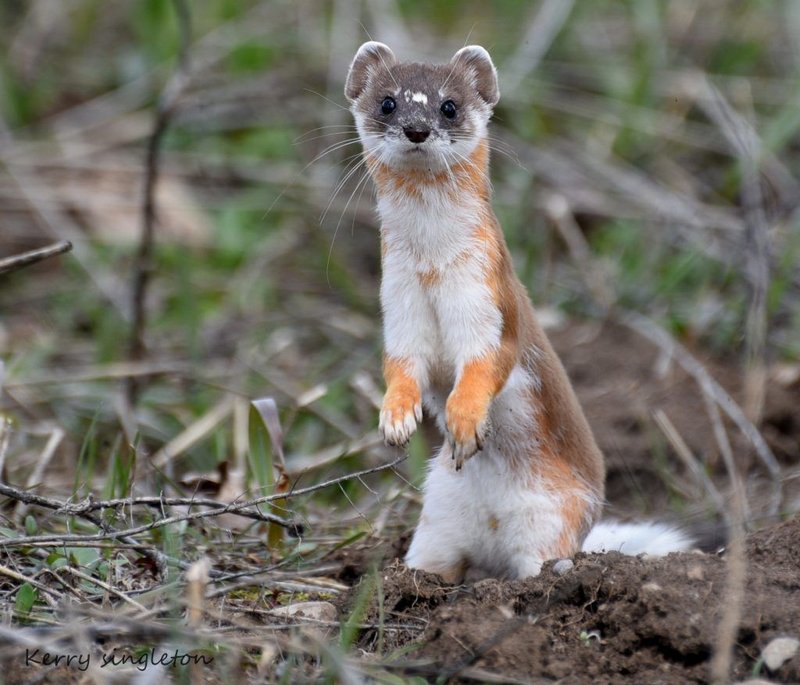
The Long-Tailed Weasel is a fascinating little creature that often intrigues nature enthusiasts. Picture this: a small, sleek animal with a long body and an even longer tail, darting through the underbrush in search of its next meal. These agile predators are known for their energy and playful behavior, making them a joy to observe in the wild. If you’re curious about what makes the long-tailed weasel so special, you’re in the right place!
These weasels are part of the Mustelidae family, which includes other well-known animals like otters, badgers, and ferrets. Native to North America, Europe, and parts of Asia, the long-tailed weasel has adapted well to various environments. From forests to grasslands, these creatures are skilled hunters, able to catch prey much larger than themselves. Let’s dive into the world of the long-tailed weasel and explore its unique characteristics, habitat, diet, and more.
Physical Characteristics
The long-tailed weasel boasts a slim body and a distinguishing long tail that can be comparable in length to its body, hence the name. They typically measure between 10 to 14 inches long, including their tail, which can be around 5 to 9 inches. This long tail isn’t just for show; it helps them balance while navigating through trees and dense vegetation.
In terms of fur, their coat is usually a rich brown on top, fading to a creamy white underneath. During winter, some populations may experience a lighter color or darker shades depending on their habitat. This coloration provides excellent camouflage, allowing them to blend seamlessly into their surroundings—an essential skill when lurking about for unsuspecting prey.
Another striking feature is their small but expressive face, characterized by a pointed snout and sharp, intelligent eyes. With their keen sense of smell and acute hearing, long-tailed weasels are well-equipped for life as predators.
Habitat and Range
Long-tailed weasels can be found in a variety of habitats. They prefer areas with a mix of open fields, shrublands, and woodlands, often near water sources. This adaptability is key to their survival; they thrive in both rural and urban settings. You might spot them in gardens or parks, where they hunt small rodents and birds.
Geographically, these weasels are widespread. You can find them across much of North America, stretching from southern Canada down to Mexico, as well as in parts of Europe and Asia. Their ability to adapt to different environments has allowed them to flourish in various ecosystems, each providing unique challenges and opportunities.
They are elusive creatures, and their natural instincts make them shy around humans. If you’re lucky enough to see one, it might be for just a fleeting moment as they scurry away. They often create burrows, which serve as dens where they can rest and raise their young while also serving as storage sites for food they’ve caught.
Diet and Hunting Behavior
When it comes to food, the long-tailed weasel is a true opportunist. Their diet primarily consists of small mammals, like mice, voles, and rabbits. They are also known to feast on birds, insects, and sometimes even reptiles. With their sharp teeth and agile bodies, they are skilled hunters that can tackle prey much larger than themselves, making them formidable predators in the animal kingdom.
What’s fascinating is how they hunt. Long-tailed weasels rely on stealth and speed, often pouncing on their prey with remarkable swiftness. They are known to use their keen sight and sense of smell to track down food, and once they’ve spotted something to eat, their excitement is almost palpable. It’s like watching a skilled athlete in action, as they maneuver through the terrain with agility and precision.
In addition to hunting, their playful nature often leads them to engage in activities that may not seem directly related to survival. You might see them chasing each other or playing in the grass—this behavior is essential for their social interactions and helps young weasels learn crucial hunting skills.
Reproduction and Lifespan
Long-tailed weasels typically breed once a year. The mating season usually occurs in late winter to early spring, and after a gestation period of about 30 to 35 days, the female gives birth to a litter of 3 to 6 kits. This is quite a significant number, considering the challenges of raising young in the wild, where predators are always lurking.
The kits are born blind and helpless, relying entirely on their mother for warmth and food. As they grow, they start to develop their hunting instincts, learning to stalk and capture prey. By the time they’re around two months old, they begin to venture out with their mother, observing her hunting techniques and gradually becoming more confident in their abilities.
In terms of lifespan, long-tailed weasels typically live around 3 to 5 years in the wild. However, those in captivity can live up to 7 years or more, as they don’t face the same threats as their wild counterparts. Their short lifespan in the wild is often attributed to predation, disease, and environmental challenges.
Behavior and Social Structure
The long-tailed weasel is primarily solitary, with individual animals marking their territory. They communicate through vocalizations and scent markings, ensuring that others know where they stand. While they may be seen paired during mating season, they generally prefer to exist alone. This doesn’t mean they’re entirely antisocial! Young weasels often play together before dispersing to establish their territories.
During the day, long-tailed weasels are mostly active during dawn and dusk, a behavior known as crepuscular. This timing allows them to hunt effectively while avoiding some of their potential predators, such as larger birds of prey or foxes. When they’re not hunting, they spend time grooming themselves to keep their fur clean and ready for action.
Interestingly, these weasels are known for their agility and acrobatic prowess. You might see them climbing trees or leaping across gaps between branches, displaying their ability to navigate different environments with ease. This agility plays a crucial role in both hunting and evading threats in the wild.
Conservation Status
As of now, the long-tailed weasel is not considered endangered, and their populations are stable. However, like many wildlife species, they face threats from habitat loss due to urbanization and agricultural expansion. It’s vital to ensure that their natural habitats remain protected, allowing them to thrive without excessive human interference.
Conservation efforts can also help raise awareness about these beautiful creatures and their role in the ecosystem. They contribute to controlling rodent populations and maintaining the balance of their habitats, making their presence beneficial to both nature and humans.
As we learn more about the long-tailed weasel, we can appreciate the importance of protecting wildlife and the environments they call home. Even small actions, like preserving green spaces or supporting wildlife organizations, can make a significant difference in ensuring that future generations can enjoy these remarkable animals.
| Scientific Name: | Mustela frenata |
| Size: | 10-14 inches (25-35 cm), tail 5-9 inches (13-23 cm) |
| Weight: | 1-2 pounds (0.45-0.9 kg) |
| Habitat: | Forests, grasslands, urban areas |
| Diet: | Small mammals, birds, insects |
| Lifespan: | 3-5 years in the wild; up to 7 years in captivity |
| Conservation Status: | Stable, not endangered |
Interesting Facts About the Long-Tailed Weasel
Long-tailed weasels have some quirky traits that make them even more intriguing. For one, they are skilled at swimming! Their slender bodies allow them to glide through water effortlessly, a handy skill when hunting for fish or escaping predators. Imagine watching one dash through the water as gracefully as a fish!
Moreover, these weasels can be quite vocal. They communicate through a series of squeaks, growls, and chirps. Each sound conveys different messages, whether it’s alerting others to danger or announcing their presence during mating season. It’s almost like they have their own little language!
Another fascinating tidbit is their tendency to play dead when threatened. This behavior can confuse predators, giving them a chance to escape. Adopting an “act” as if they’re no longer a threat makes them less appealing as prey, showcasing their cleverness.
FAQ
What is the primary diet of the long-tailed weasel?
The long-tailed weasel primarily preys on small mammals like mice and voles. They are opportunistic hunters, also consuming birds, insects, and occasionally reptiles. Their hunting skills and adaptability to different foods allow them to thrive in various environments.
Are long-tailed weasels social animals?
Generally, long-tailed weasels are solitary creatures. They mark their territory and communicate through scents and vocalizations. While they may form temporary bonds during mating season, they prefer to live alone and establish their territories as individuals.
Where can I find long-tailed weasels?
Long-tailed weasels inhabit a wide range of environments, including forests, grasslands, and urban areas. They are found across much of North America, Europe, and parts of Asia, showing their remarkable adaptability to various habitats.
How do long-tailed weasels adapt to their environment?
Their agile bodies and sharp senses allow them to adapt well to different habitats. They are excellent climbers and swimmers, enabling them to navigate diverse landscapes. Their coloration also helps them blend into their surroundings, making them effective hunters.
What are some common predators of the long-tailed weasel?
Common predators include larger birds of prey, foxes, and larger mammals. Their ability to quickly dash away and find cover helps them evade these threats, but they must always stay alert to survive in the wild.
How long do long-tailed weasels live in the wild?
In the wild, long-tailed weasels generally live for about 3 to 5 years. However, those in captivity can often reach ages of 7 years or more, thanks to the absence of natural threats that they face in their wild habitats.
Is the long-tailed weasel endangered?
No, the long-tailed weasel is currently not considered endangered. Their populations are stable, though they face threats from habitat loss. Conservation efforts are crucial to protect their habitats and ensure their continued presence in the wild.
Do long-tailed weasels have any unique behaviors?
Yes! They are known for their playful antics and can often be seen engaging in playful behaviors, like chasing each other. Also, when threatened, they may play dead to confuse predators. This clever tactic can sometimes save their lives!
Can long-tailed weasels swim?
Absolutely! Long-tailed weasels are quite adept at swimming. Their slender bodies help them navigate through water efficiently, which can be beneficial for hunting or escaping danger in aquatic environments.
What role do long-tailed weasels play in the ecosystem?
Long-tailed weasels play a vital role in controlling populations of small mammals and insects. By keeping these populations in check, they contribute to the ecological balance of their habitats, promoting healthier ecosystems.
How can I help protect long-tailed weasels?
You can help protect long-tailed weasels by supporting conservation efforts and organizations focused on wildlife protection. Simple actions like preserving green spaces, creating wildlife-friendly gardens, and spreading awareness about their importance can make a significant impact.

